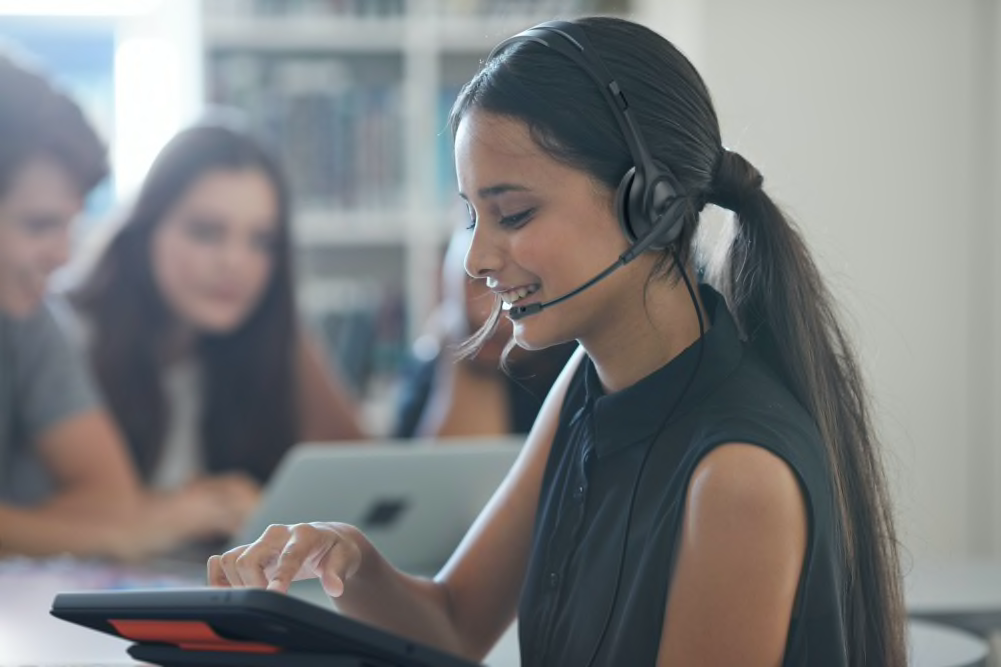3 Simple Solutions for Classroom Noise Pollution
Teaching strategies and technologies that make classrooms quieter

Let’s reassess noise in the classroom and its impact on learning. As students contend with new and more sounds, it’s harder for them to stay focused, especially when classrooms have been found to be as noisy as city traffic.CDC What Noises Cause Hearing Loss (November 2022).
The most effective solutions will be student-centered policies, including taking advantage of 1:1 device environments and new instructional methods. By thinking about how to handle classroom noise in three broad categories, educators can test approaches that give students more control over the ways they hear and are heard in class.
Turn up instruction
To avoid learning loss, students need instruction to be 15-20 decibels louder than background noise.Novanta, G.,Garavelli, S., Sampaio, A.,Is the Level of Noise in a School Environment Harmful to the Hearing of Teachers Study (2020). But providing instruction at the right volume isn’t as simple as teachers speaking louder. Many educators are already straining their voices in the classroom and 75% report their voice is hoarse and strained from teaching.Logitech and Education Week Survey (August 2022).
When teachers find a way to turn up the volume of instruction, without doing harm to themselves, the results are amazing! Sound-field studies show that amplifying a teacher’s voice results in an exceptional improvement in reading and language test scores for all students at all elementary levels.MARRS Project, 2005b Mainstream Amplification Resource Room Study.
How to do it
There are technology and non-technology strategies to try. If student voices are driving noise levels up in a classroom, teachers and other school leaders can use practices they are already familiar with: call-and-response and clapping response strategies.MARRS Project, 2005b Mainstream Amplification Resource Room Study. These are often quick and helpful ways to bring attention back to the teacher or adult in the room.
The Yeti Nano Microphone is another helpful resource because it amplifies the voices of educators. Yeti Nano provides a broadcast-quality sound that gives educators’ voices exceptional presence and detail. Educators won’t be stuck at their desks or in a certain position, either. The omnidirectional microphone makes it easy for teachers and others to be heard no matter where they are in a room.
Turn up student voices
Educational apps are a big part of learning experiences. Students may listen to instructions from apps or interact with them in other ways. To fully engage in learning, students need to be heard by the programs they use.
As students are physically developing, their voices may be changing or softer than adults. Other students may have not yet developed the confidence to speak loudly. Not being heard by other students or educators can exacerbate this challenge. Studies have found 15% of students feel embarrassed or report a lack of confidence because of bad audio.EPOS Understanding Sound Experience Study (2020).
How to do it
Setting up quiet technology corners or placing barriers between students can help students’ voices be heard more clearly by apps. Adding headsets with microphones can help turn up the volume on student voices in a way that is not distracting to others. Logitech H111 headset has a built-in microphone that can be worn on the left or right and positioned close to students’ mouths so they can be heard clearly.
Turn down classroom noise pollution
Classroom noise pollution can make students lose focus and motivation,leading to learning challenges.Research has shown that high ambient noise leads to “significantly worse standardized test results” among students who are ages 8-10.Pujol, S., Levain, J., Houot, H., Petit, R., Berthillier, M., Defrance, J., . . . Mauny, F. Association between Ambient Noise Exposure and School Performance of Children Living in An Urban Area: A Cross-Sectional Population-Based Study. Journal of Urban (2013) .
Educators can help students focus by identifying what is contributing to classroom noise pollution, including room acoustics, objects, and other distracting sounds.
How to do it
Adjusting acoustics by putting in additional rugs or soft materials on the walls of a classroom to absorb noise pollution can help. Teachers can also use strategies such as designating certain times for talking and collaborating, using visual queues for quiet, structuring class time to start in a quiet manner, and other ideas.MARRS Project, 2005b Mainstream Amplification Resource Room Study.
Peripherals such as headsets are useful too. But it’s important that they fit students so classroom edtech enhances, not hinders, learning. Logitech H111 headset has leatherette ear cushions that keep students comfortable.
There are few, practical ways to eliminate classroom noise completely. But by focusing on these three areas, educators can make a big difference in helping students hear and be heard.
YOU MAY ALSO BE INTERESTED IN
Let’s Talk
Learn more about how Logitech can help you shape the future of education.
Contact Sales
THANK YOU FOR CONTACTING US
A product expert will reach out to you shortly.